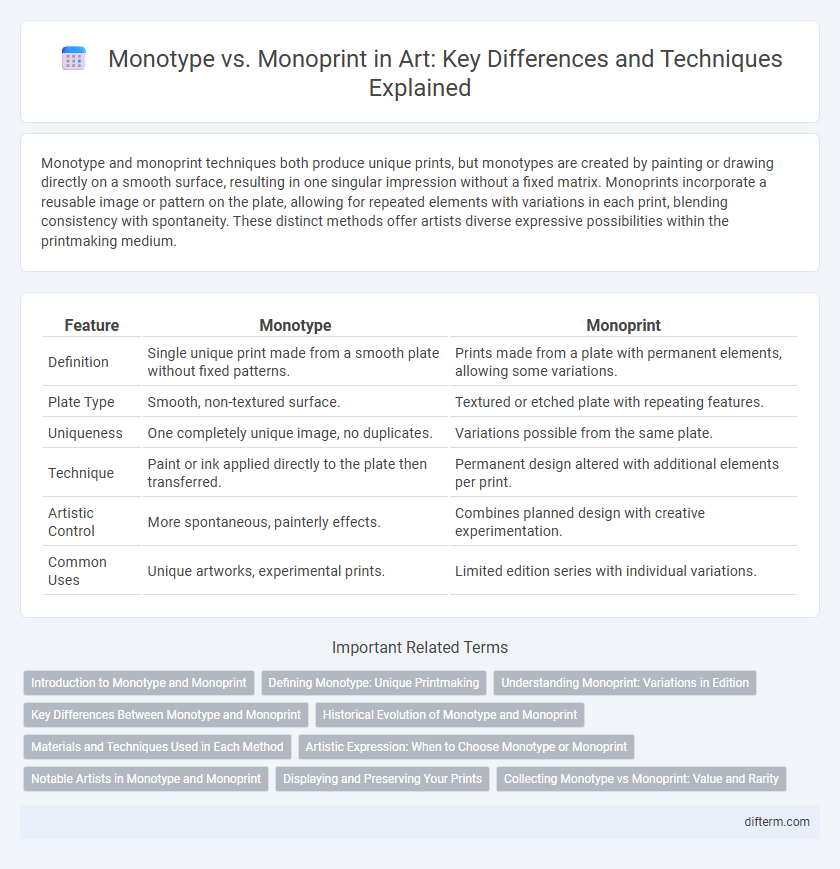Monotype and monoprint techniques both produce unique prints, but monotypes are created by painting or drawing directly on a smooth surface, resulting in one singular impression without a fixed matrix. Monoprints incorporate a reusable image or pattern on the plate, allowing for repeated elements with variations in each print, blending consistency with spontaneity. These distinct methods offer artists diverse expressive possibilities within the printmaking medium.
Table of Comparison
| Feature | Monotype | Monoprint |
|---|---|---|
| Definition | Single unique print made from a smooth plate without fixed patterns. | Prints made from a plate with permanent elements, allowing some variations. |
| Plate Type | Smooth, non-textured surface. | Textured or etched plate with repeating features. |
| Uniqueness | One completely unique image, no duplicates. | Variations possible from the same plate. |
| Technique | Paint or ink applied directly to the plate then transferred. | Permanent design altered with additional elements per print. |
| Artistic Control | More spontaneous, painterly effects. | Combines planned design with creative experimentation. |
| Common Uses | Unique artworks, experimental prints. | Limited edition series with individual variations. |
Introduction to Monotype and Monoprint
Monotype and monoprint are unique printmaking techniques distinguished by their reproducibility and image characteristics. Monotype produces a single, one-of-a-kind print by painting or drawing directly onto a smooth surface, while monoprint allows limited variations through repeated use of a fixed matrix combined with unique alterations. These methods emphasize spontaneity and texture, offering artists creative flexibility beyond traditional printmaking.
Defining Monotype: Unique Printmaking
Monotype is a printmaking technique characterized by creating a single, unique impression from a smooth, unetched plate, typically made of glass or metal, resulting in one-of-a-kind artworks. Unlike monoprints, which may involve repeated prints with varying elements or fixed matrix patterns, monotypes produce prints with no permanent image on the plate, ensuring each print cannot be duplicated exactly. This uniqueness makes monotypes highly valued in fine art for their spontaneous and painterly qualities, blending drawing and printmaking methods in a singular creation process.
Understanding Monoprint: Variations in Edition
Monoprint is a unique printmaking technique characterized by its one-of-a-kind variations within an edition, where each impression contains elements that cannot be exactly replicated. Unlike monotype, which produces a single singular impression from a painted or inked plate, monoprints incorporate a fixed matrix combined with changing features like hand coloring or added textures. This hybrid approach ensures that every print in a monoprint edition holds distinct artistic value and subtle differences, making each piece an individual work despite sharing a base design.
Key Differences Between Monotype and Monoprint
Monotype produces a single unique print from a smooth plate, resulting in one-of-a-kind artwork with no permanent patterns, while monoprint incorporates fixed elements or textures, allowing multiple variations from the same base. The monotype process emphasizes spontaneity with unpredictable outcomes, whereas monoprint combines repetition and variation through established motifs or matrices. Artists choose monotype for singular, painterly effects and monoprint for controlled experimentation within a series.
Historical Evolution of Monotype and Monoprint
Monotype and monoprint have distinct historical evolutions rooted in printmaking traditions. Monotype emerged in the 17th century, attributed to artists like Giovanni Benedetto Castiglione, who pioneered this one-of-a-kind print technique by painting on glass or metal plates. Monoprint developed later, allowing variations on a printed matrix, gaining prominence in the 19th and 20th centuries as artists such as Edgar Degas and Robert Rauschenberg expanded its creative possibilities.
Materials and Techniques Used in Each Method
Monotype prints use a smooth, non-absorbent surface such as glass or metal plates, where artists apply ink or paint directly, creating unique images through a single pressing onto paper. Monoprints combine fixed elements like etched plates or stencils with varied ink application, allowing for multiple impressions that retain unique differences in each print. The materials in monotype emphasize spontaneous brushwork and ink manipulation, while monoprints rely on the interplay between permanent textures and customized ink overlays.
Artistic Expression: When to Choose Monotype or Monoprint
Monotype offers a unique artistic expression with each print being one-of-a-kind, ideal for artists seeking spontaneity and fluidity in texture and color blending. Monoprint allows for more controlled repetition by incorporating consistent elements while varying others, making it suitable for exploring themes with subtle variations. Choosing between monotype and monoprint depends on the desired balance between singular creativity and iterative experimentation in printmaking.
Notable Artists in Monotype and Monoprint
Notable artists in monotype include Edgar Degas, whose innovative use of monotype techniques brought a painterly quality to printmaking, and Joan Miro, who expanded the medium with vivid abstraction. Monoprint is distinguished by artists like Pablo Picasso, who exploited the technique's unique textural possibilities, and Robert Rauschenberg, whose experimental approach merged printmaking with collage. These artists significantly contributed to the evolution and recognition of monotype and monoprint within contemporary art.
Displaying and Preserving Your Prints
Monotypes create unique prints with a single impression, making each piece one-of-a-kind and ideal for display in limited editions to maintain exclusivity. Monoprints allow for variations using a consistent matrix, providing artists more flexibility while still enabling collectors to preserve the original plate or stencil for future reproductions. Proper framing with UV-protective glass and controlled humidity conditions ensures longevity and vibrant color preservation for both monotypes and monoprints.
Collecting Monotype vs Monoprint: Value and Rarity
Collecting monotypes offers higher value and rarity due to each print being a unique one-of-a-kind creation, impossible to replicate exactly. Monoprints, while also unique, often derive from a repeatable matrix, making them slightly more common and less exclusive in comparison. The scarcity and singular nature of monotypes generally result in greater demand and collectible significance in the art market.
monotype vs monoprint Infographic

 difterm.com
difterm.com